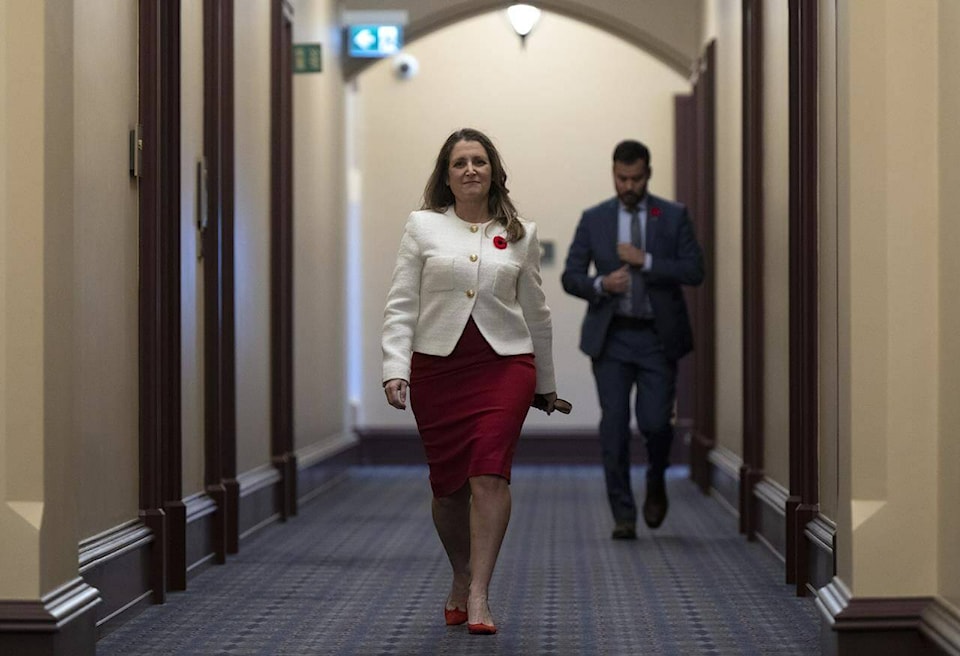Finance Minister Chrystia Freeland’s fall economic update creates two new federal tax credits for clean technology and low-emitting hydrogen production, with the caveat that companies that pay fair wages and train apprentices will get a bigger credit than those that do not.
The statement tabled in the House of Commons on Thursday is Freeland’s first big push to keep Canada in the clean-tech economy race in the shadow of the massive Inflation Reduction Act south of the border, and move Canada’s transition to a green economy further along.
“The green transition is the most significant economic transformation since the Industrial Revolution,” Freeland said.
The Inflation Reduction Act, signed into law in August by U.S. President Joe Biden, invests nearly US$400 billion in everything from critical minerals to battery manufacturing, electric vehicles, and clean electricity, including hydrogen.
Experts and industry associations have been warning ever since that Canada would be shoved aside in the global competition for investment, skilled workers and materials if it did not step up and do more to match the U.S. investments.
Freeland said the fall update is just the “down payment on the work that lies ahead to respond to the inflation Reduction Act.”
Most of the heavy lifting to respond will need to wait until the Liberals introduce the next federal budget, expected in spring 2023.
But Freeland outlined in Thursday’s mini-budget the broad strokes of some of it, including launching consultations to design an investment program for electric vehicle and battery manufacturing and plans to create a new tax credit for companies that start producing low-carbon hydrogen.
That credit is being carved away from the clean-tech investment tax credit she said last April would be ready in time for this fall update.
Freeland made good on that promise, introducing an investment tax credit of up to 30 per cent for renewable electricity systems, industrial electric vehicles, energy storage systems and heat pumps. The credit will kick in the day the 2023 budget is tabled and Freeland expects it to cost almost $6.7 billion over the next five years.
The credit will be phased out starting in 2032 and end entirely in 2035.
Hydrogen was going to be included in that program but that is no longer the case. It will get its own tax credit of up to 40 per cent of the investments made to produce low-emitting or zero-emissions hydrogen. The size of the credit will be tied to the size of emissions from a production facility, with the final details worked out in time for the spring budget.
Mark Zacharias, the CEO of Clean Energy Canada, a renewable energy think tank at Simon Fraser University in Burnaby, B.C., said splitting the hydrogen credit out is a smart move because it mirrors what the U.S. did in the Inflation Reduction Act.
He said Canada’s tax credit isn’t identical, but along with clean tech credit, it will keep Canada competitive with the U.S.
“This (update) does help close the gap between the Inflation Reduction Act in the U.S. and make Canada a little bit more competitive in the clean technology space,” he said.
“I think it’ll catalyze climate spending in Canada, both public and private.”
Both tax credits will, for the first time, include labour conditions that make them more lucrative for companies that pay fair market wages and include apprenticeship training for young workers.
The idea was taken from the U.S. Inflation Reduction Act and Freeland said it is one of the most noteworthy policies in her economic statement.
“Our basic view is if the government is investing in businesses, encouraging them to do things that we need done … it is entirely reasonable, in fact, I would say long overdue, for us to say ‘and as you’re doing it, you need to be creating good paying jobs for Canadian workers.’”
Government officials indicated Thursday that if the labour conditions are successful in this initial context they likely will become a common part of any future government investment programs.
Freeland also used the update to release more details of the new Clean Growth Fund she promised in last spring’s budget, and says it will launch before the end of the year with $15 billion in startup capital.
The Liberals are hoping the fund will ease the risks of investing in emerging clean technologies and attract “substantial private sector investment.”
The update also includes some movement on the government’s promise to help retrain workers to succeed in clean technology companies, with $250 million over the next five years to create two new sustainable job training programs.
One would build a new training centre that could retrain 15,000 workers in low-carbon economy jobs, and the other would fund apprenticeship training through an existing union training program.
—Mia Rabson, The Canadian Press
RELATED: Freeland budgets billions more for testing, treatments and vaccines in fall update
